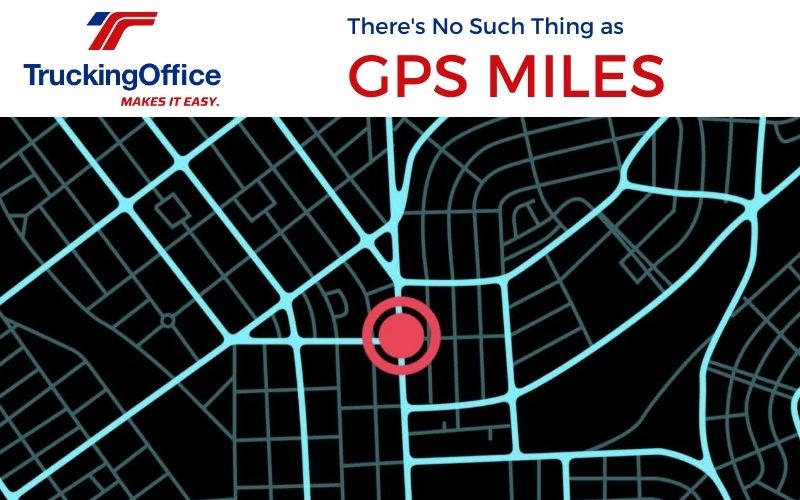Mileage matters more to truckers than probably to anyone else. We get paid per mile. We get taxed per mile. Even when we’re on vacation, we track miles per state. So what are we talking about when we say that there’s no such thing as GPS miles?!
GPS Miles?
We need to start with exactly what GPS stands for: Global Positioning System.
What is GPS?
The Global Positioning System (GPS) is a space-based radionavigation system, owned by the U.S. Government and operated by the United States Air Force (USAF). It can pinpoint a three-dimensional position to meter-level accuracy and time to the 10-nanosecond level, worldwide and 24/7.
What is GPS? | NASA
Radio-navigation what? That’s the part that tells us where we are. Satellites get a signal from us and it sends back a signal that our computer systems locate on a map.
GPS is a three-part system: satellites, ground stations, and receivers. Satellites act like the stars in constellations—we know where they are supposed to be at any given time. The ground stations monitor and control the satellites, and they help determine their locations—both where they were and where they are forecast to be. A receiver, like you might find in your phone or in your car, is constantly listening for signals from these satellites, which can be used like a giant tape measure between the receiver and satellites.
NOAA
It’s no wonder that 30 years ago, people worried about being tracked by the government if that’s what GPS does. But now we’ve learned how to use GPS for ourselves – to the point that some people can’t read a paper map, much less refold them.
We use GPS constantly now. It’s not just for locating ourselves. We now can receive notifications about traffic jams with suggestions for rerouting. Use the right software and you’ll hear about speed traps, trash on the road, or accidents ahead. That’s not part of the GPS system. It’s simply an indication of how much we use GPS in our daily lives and interact with it.
But GPS isn’t about miles or roads.
Where are you?
GPS is a positioning system. It is not a mapping program.
That’s what the software does. It takes the location information – yours and the GPS system’s – and plots it on a map. Those extras – speed traps, trash, etc. – are people from people who kindly add that information to the system. All GPS does is say where the receiver is based on the signals the system gets.
GPS only identifies positions. Your software puts that position on the map.
So you need a good mapping software to use GPS because GPS doesn’t know how far away your destination is from where you are now.
Highway curves
The Indiana Toll Road was built on some of the flattest land in the country. Sure, there’s a lot of flat land in the US, but the engineers back the day deliberately planned that highway to have curves. It wasn’t to go around hills or valleys, or even to respect property owners. They did it to keep drivers from going into a stupor from driving miles and miles in a straight line (according to my uncle who helped build it.) And having driven I-80 through northern Indiana countless times, I get it. Mile after mile of cornfields in a straight line and I’d be asleep at the wheel.
So if GPS says I’m at a certain point – say the eastern end of the Indiana Toll Road – and I want to go to South Bend to my uncle’s house, GPS can identify the locations. My GPS can tell me where those are – but they can’t tell me the mileage between them. Because the roads aren’t straight. I actually have to drive past my uncle’s house on I-80 and backtrack a bit to get to his place. But GPS doesn’t know that there isn’t a direct road between the Ohio border and a specific street in South Bend, Indiana.
That’s why there’s no such thing a GPS miles. GPS doesn’t look at roads. It looks strictly at places, points on a map. How you get from here to there isn’t what GPS is going to help you do.
PC*MIler + TruckingOffice = Real Miles
What we use is a mapping program that does look at roads. That identifies the best routes between point A and point B based on the most important criteria. As a trucker, we need a route that won’t get us stuck at a bridge that’s too low or direct us to drive down a road that had a weight limit.

That’s why PC*Miler is so important in dispatch routings. You need accurate route information that means an 18-wheeler can use it, not your grandma’s Chevy Impala.
GPS miles don’t matter. Road miles do. Safe road miles are the most important.
So use a routing system that works for truckers. That would be TruckingOffice PRO and PC*Miler.
We know there are truckers who still want to avoid the costs of using a complete trucking software. They’re making do with Google Maps and Google Sheets and Google Docs. But the expense of time must be considered. What if you get a bad route courtesy of Google Maps? It might steal hours from your day and add extra miles that you didn’t count on.
When it comes to paying IFTA and IRP, having accurate miles is critical to paying exactly what you owe. An audit can be costly – even putting you off the road. So keep those road miles precise. The best way to do that is to use a trucking software that will use those numbers time and again without you re-entering the data.
Use a trucking software package eliminates those risks.
There’s no such thing as GPS miles? No worries! We’ve got your miles via PC*Miler, the government standard. (The DOT uses PC*Miler too!) Your routes will be the best possible options for you. You can protect your business from disasters with PC*Miler and TruckingOffice PRO.
Have confidence that you’re building the best trucking business by using TruckingOffice PRO. We’ll let you try it out for free!







Recent Comments